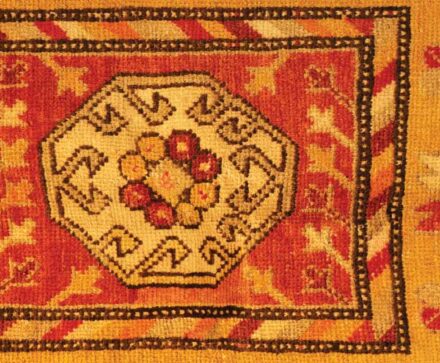What Are Kilim Rugs?

Kilim rugs are more than just rugs; they are works of art. Sam Presnell, owner of The Rug Gallery, discusses the beauty and design of kilim rugs. Listen or read more to find out if a kilim rug is right for your home.
LISTEN NOW
John Maher: Welcome to The Rug Gallery with Sam Presnell. The Rug Gallery is an oriental rug company and carpet store in Cincinnati, Ohio. I’m John Maher. I’m here with the owner of the Rug Gallery, Sam Presnell. Hi, Sam.
Sam Presnell: Hi, John.
John: Sam, today we’re talking about kilim rugs. What is a kilim rug?
Sam: Just like the word says, flat woven. That’s what it means.
Origin of Kilim Rugs
John: Okay. Flat woven. Where do kilim rugs come from?
Sam: Well, there’s lots of places but mostly in the beginning, they were more tribal, they were more of the nomadic tribes, the sheep herding tribes that would wander to grasslands mostly. In Central Asia, you would find … predominantly Turkey, Iran areas probably the biggest area where you find most flat weaves or kilims.
What makes kilim rugs unique?
John: What makes kilim rugs unique?
Sam: Well, I think what makes it unique is not only that they’re flat woven, but they’re very pliable, they’re very lightweight, they’re very decorative and their colors are usually very bold, most of the time very bold geometric and have bright colors to them. They’re just, I just think, a very unique, artsy type of rug.
Difference Between Flat-Woven Rugs and Oriental Rugs
John: When you say flat woven, can you describe that a little bit on what that means and how that’s different from what we might think of is like a regular oriental rug type?
Sam: If you look at an oriental rug, or you look at carpeting, it’s all got a real thick pile to it usually and you can feel a lot of weight to it, whereas a kilim will be more like a shirt or slacks or like a textile that you would use for other things. It’s a flat-woven piece. Actually, instead of not in a pile, it’s more of a continuous looping in and out of the warp strands in a loom. Basically, the yarns are laying on its side instead of on its tips like you would find in a regular oriental rug.
Decorating with a Kilim Rug
John: Okay. How does that change things in terms of how you might display a kilim rug or use it in your home? Is it still just on the floor? Is it on a rug pad? Does it create any kind of issues in terms of traffic walking over it or anything like that?
Sam: As far as usage goes, that is a great thing about kilim is that we use them in every kind of situation you can imagine. We do a lot of them for wall pieces, very decorative wall pieces like a piece of art. We do a lot of tapestries. I see people put their furniture in them as well as like Ottomans and chairs comes off very, very cool. As far as using them on the floor, I think that’s also a big issue with them because they are very pliable. They are going to move in scootch and wrinkle and they’re not going to lay perfectly flat. I think a lot of people expect it to behave like a thick piece of carpet, it doesn’t. You do need special pads, really thin, dense pads which have total gripping ability to them to keep them behaving properly. That’s one of the issues if you use them on the floor. One of the nice things about kilims, not always, but in most cases, you can use and flip both sides over, it’s a reversible rug. You’ll be able to rotate four corners basically in the traffic situation, which is nice as well.
How to Choose a Kilim Rug
John: Okay, and what should you look for when you’re shopping for a kilim rug?
Sam: I think the most important thing is the finesse of the wool. The wool is the most important part of that particular rug — how well it’s put together and how dense it is and then look at the designs and how crisp and clear they are. The coarser the weave, the coarser the wool, the less crispness you’ll have to it. But maybe you want that less crispness and want more crudeness and, of course, that would be a less expensive kilim as well, and maybe more to your liking.
I would say the big thing, like art, is that it’s how the weaver interpreted colors and designed together. I still can remember junior high school going out front of the old school, … and we all took our watercolors out and we painted the front of the school. At the end of the day, we brought it back in and we had 25 pictures or paintings of the school. You couldn’t believe how different everyone was. [chuckles] People were very skilled at mixing their colors and how they interpreted it, it was fantastic.
John: All right. That’s really great information, Sam. Thanks again for speaking with me today.
Sam: You’re welcome, John.
John: For more information about Sam, The Rug Gallery and oriental rugs and carpets visit The Rug Gallery online. Or call 513-793-9505. Make sure you catch the latest episodes by subscribing to this podcast on iTunes. If you could take the time to give us a review on iTunes as well, we’d appreciate that. I’m John Maher. See you next time on The Rug Gallery.

